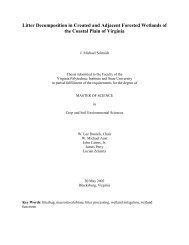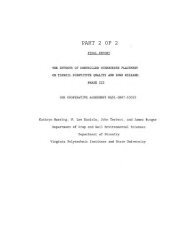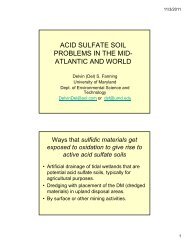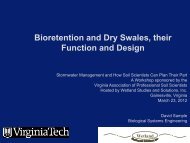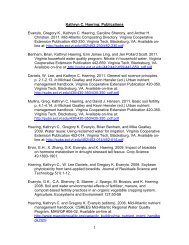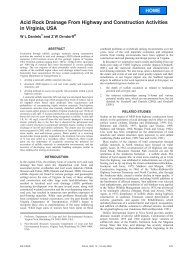Remediation of PAH-Contaminated Soils and Sediments: A ...
Remediation of PAH-Contaminated Soils and Sediments: A ...
Remediation of PAH-Contaminated Soils and Sediments: A ...
You also want an ePaper? Increase the reach of your titles
YUMPU automatically turns print PDFs into web optimized ePapers that Google loves.
increasing rainfall intensity or wind speed, soil particles are more likely to be<br />
detached <strong>and</strong> transported (Toy et al., 2002).<br />
<strong>PAH</strong> Degradation<br />
Degradation rates <strong>of</strong> <strong>PAH</strong>s vary depending on molecular weight <strong>and</strong> solubility <strong>of</strong><br />
the <strong>PAH</strong> compound (Alex<strong>and</strong>er, 1999). Polycyclic aromatic hydrocarbon<br />
compounds can be grouped into different degradation <strong>and</strong> sequestration<br />
fractions in both soil <strong>and</strong> sediments depending on their bioavailability. Brion <strong>and</strong><br />
Pelletier (2005) suggested dividing them based on decreasing availability into the<br />
following phases:<br />
� water-extractable phase (or easily degraded)<br />
� slow molecular diffusion <strong>of</strong> <strong>PAH</strong>s into microsites (transition)<br />
� sequestered residual phase which requires extraction with organic<br />
solvents<br />
The ultimate goal <strong>of</strong> degradation is the complete mineralization <strong>of</strong> <strong>PAH</strong>s to CO2,<br />
water, microbial carbon, <strong>and</strong> other inorganic compounds (Lundstedt, 2003).<br />
Unfortunately, degradation <strong>of</strong> <strong>PAH</strong>s may result in the accumulation <strong>of</strong><br />
metabolites (mainly ketones, quinones, dicarboxylic acid anhydrides <strong>and</strong><br />
coumarins) that can be more toxic <strong>and</strong>/or more soluble than the parent<br />
compound (Lundstedt, 2003). For example, fluoranthene degradation has been<br />
found to produce more soluble <strong>and</strong> potentially leachable metabolites (Vessigaud<br />
et al. 2007). Haeseler et al. (2001) showed enhanced, but incomplete,<br />
degradation <strong>of</strong> <strong>PAH</strong> compounds in a field study <strong>and</strong> noted a brief spike in<br />
leachate toxicity due to the accumulation <strong>of</strong> more soluble metabolites. However,<br />
after remediation was complete, final toxicity was negligible because the<br />
metabolites tended to be less stable <strong>and</strong> more soluble than the parent<br />
compounds, making them more available to degraders (Haeseler et al., 2001).<br />
Intermediates <strong>of</strong> <strong>PAH</strong> degradation are not always bioavailable <strong>and</strong> can also be<br />
incorporated into the humic fraction <strong>of</strong> soil, making them less available <strong>and</strong> less<br />
toxic (Kastner et al., 1999).<br />
Biological: Microbial communities (including bacteria <strong>and</strong> fungi) can biologically<br />
degrade <strong>PAH</strong> compounds during direct microbial metabolism <strong>of</strong> carbon <strong>and</strong><br />
energy sources or by cometabolism while consuming another substrate<br />
(Lundstedt et al., 2007). Biological degradation is highly dependent upon several<br />
abiotic soil factors, including (Eweis et al., 1998; Huesemann, 2004):<br />
� nutrients<br />
� pH<br />
� metals<br />
� temperature<br />
23



